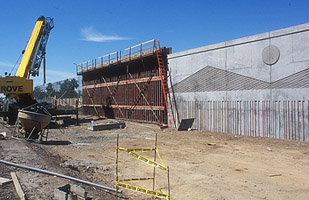Listen Up: ADOT works to minimize noise impacts
Listen Up: ADOT works to minimize noise impacts

Concrete noise walls reduce traffic noise by blocking the path that sound waves travel from the traffic to the residential area.
Most people don’t find the sound of traffic especially soothing …
ADOT certainly recognizes this and is constantly working to minimize the impacts to surrounding neighborhoods from the noise of new freeways.
You would think figuring out the impact of noise could get tricky because everyone perceives it differently – a sound that’s irritating to you might be tolerable to someone else.
But, federal law requires that ADOT estimate the future noise levels from new freeway projects, and if traffic noise approaches or exceeds 67 decibels, noise abatement must be considered. ADOT has taken it a step further, though, and considers 64 decibels to be the acceptable threshold to consider noise abatement for new projects.
The amount by which noise levels will change in a residential area also is a factor. A road project that will cause noise levels to increase by 15 decibels or more is considered an impact and noise abatement measures must be considered.
Just to give you an idea of what a decibel measurement means … a whisper could register at about 20 decibels, normal conversation comes in around 60 decibels and if you were standing about 15 feet from a loud rock band, you’d be hearing sounds measuring roughly 130 decibels.
Now you might be asking – how do you figure how noisy a new road will be before it’s even built?
Well, experts from ADOT’s Environmental Planning Group use sound pressure level meters to take readings of current noise levels in several areas near a proposed project site.
Measurements aren’t taken during rush hour because traffic is typically a little slower and quieter. Measurements are instead taken at the peak traffic noise hour, when traffic is free-flowing and cars are able to drive the speed limit, but the road is at maximum capacity.
Those measurements and the area’s topographic and weather information are plugged in to a very sophisticated computer program. It creates a model of the area and can tell ADOT what noise levels to expect if a new freeway is built, or an existing freeway is widened.
If it is determined a project will cause a noise impact to the area, ADOT has a few options, including:
- Install noise walls or berms
- Implement traffic control measures (speed limits, etc.)
- Modify the proposed freeway alignment
On top of everything, the abatement method chosen has to meet multiple criteria showing that it is reasonable and feasible … a noise wall isn’t reasonable if the residents of the neighborhood don’t want it or it is cost prohibitive and it isn’t feasible if it won’t effectively reduce noise levels.
A little more on noise walls …
Barriers, such as concrete noise walls, reduce traffic noise by blocking the path that sound waves travel from the traffic to the residential area.
When sound waves hit the noise wall, they must bend over and around it. This is known as diffraction, which absorbs the sound energy, thereby reducing noise. For every decibel of reduction, it is necessary to increase the height of the wall by two feet. Noise walls are most effective when the distance between the source and the receiver is no more than 400-500 feet.
ADOT and the Federal Highway Administration (FHWA) are currently studying the use of rubberized asphalt or “quiet pavement,” which can noticeably reduce traffic noise levels. When ADOT/FHWA completes the study, the results will determine whether quiet pavement can be used for noise abatement.
While no analysis, wall or special pavement can completely eliminate traffic noise, ADOT does have one of the most progressive noise abatement policies in the nation and that is something the citizens of Arizona may find soothing.
